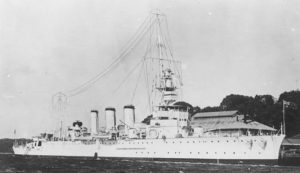- Author
- Letter Writer
- Subjects
- Ship design and development, Naval technology, Letter to the Editor
- Tags
-
- RAN Ships
- HMAS Adelaide I
- Publication
- September 2005 edition of the Naval Historical Review (all rights reserved)
Dear Sir,
Congratulations on Graeme Andrews’ excellent and timely article on the “forgotten” cruiser, HMAS Adelaide. The front cover shows one of the 6″ Mark XII guns, not gun mounting (as in the caption). [Ed: at the time uploading this article, the front cover was not available].
In the article’s comparative data section there is reference to 6″ Mk XIII guns. There were a small number of Mk XIII guns made for the RN, but they were really an export version of the older and inferior Mk XI and used aboard the battleship HMS Agincourt and a few of the Insect Class river gunboats. The confusion arises for Adelaide as the ship carried the widely-issued Mk XII gun on a PXIII (sometimes called Mk XIII) mounting. The PXIII mounting is usually listed as having a max elevation of 30 deg, which would give the Mk XII gun a max range of about 18,700 yds. The article suggests a max range of 17,000 yds, which might be so if the guns had worn and not been replaced. (The RN had superchargers available for these guns which could push the range out to approx 23,000 yds, but I don’t know if these ever found their way to the RAN. Perhaps some of the wartime crew might remember). If the elevation of the mount was limited to 20 deg (which I doubt) the range would have dropped to well below 16,000 yds (John Campbell’s famous book is the best source I am aware of).
The rate of fire of 45 rounds a minute is an obvious typo…

It is sometimes claimed that Adelaide was built to the more obsolescent design than the Arethusa or “C‘ Class ships of the early war years, as the RN wanted a larger vessel suitable for ocean patrol work (vide British Cruisers by HT Lenton). I would suspect that Adelaide (laid down in 1915) was the result of decisions taken years earlier. It seems to be very sensible to have a homogeneous squadron of very satisfactory light cruisers and there may have been a conservative reluctance to introduce oil firing for ships in this part of the world, despite the fact that the RN had decided to follow that path just before WW1. Has anyone had access to Admiralty papers, which led to the decision to order the fourth light cruiser for the RAN?
The photos in the article are most pleasing and I feel that Adelaide was more handsome as a three-funnel ship. It is a pity the original refit for 1938 was not carried out, which would have led to the trunking of the 3rd and 4th funnels and a reduction of the main armament to six 6″ guns, laid out on the centre line like the RN “D” Class units. Extra 4″ AA guns were to be added and a HA DCT at the foot of the tripod mast. The modifications saved space and weight would have allowed the 4″ guns to be twinned (as done later in HMAS Hobart – but not Sydney II in WW2). Has any reader a sketch or diagram of this unfulfilled refit plan for Adelaide?
Even with the refit Mr Andrews is right; she would have had no chance if she had run into US Tone or any other Japanese heavy cruiser. All the same, Adelaide proved a most useful and busy RAN unit and the article is certainly one to be commended.
Revd Michael Head (Parkville, VIC)
(The writer certainly adds further interest to the REVIEW 02/05 article. Can any reader or former crewmember answer his questions above?)
Followup on “HMAS Adelaide 1918 – 1949”
- As indicated in the article, other relics from the cruiser Adelaide remain elsewhere. The wardroom dining table (and chairs) serves on in the quiet surrounds of Master Attendant’s conference room in the Clocktower Building in Garden Island Dockyard, Sydney. A brass plaque reads:
Wardroom Table of the light cruiser HMAS ADELAIDE 1918 – 1949.
5440 tons 9 x 6″ guns 3 x 4″ guns.
(Do any readers know of any other relics of this old ship which are preserved or on display somewhere? If so, please advise the Editor who will pass this information on to the RAN Heritage Collection for archival reference.)
- Erratum: In the comparative data table at the end, Adelaide was credited with “…45 rounds per minute.” This should read “4 – 5 rounds per minute” – even though this was a crack gunnery ship, the guns were hand-loaded!




